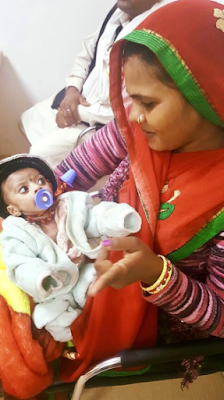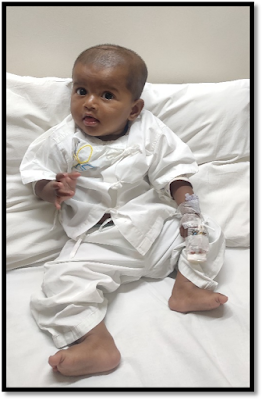Each day I am reminded of how deeply flawed our world is. Power,
greed and sometimes sheer neglect has resulted in so much human suffering, it hurts my heart and soul just to think about it. In the midst of all this turmoil, it’s difficult to see the beauty, the magic and the hope that still exists. It does
exist, and there are lots of precious moments that allow us to see the world again with optimism and hope for what lies ahead.
I often experienced such moments-the baby yet to be named -and therefore referred as Baby of Rekha. He had undergone a complicated heart surgery about a month ago, and was here that day for a follow up visit. Seeing the little child, barely 3 months old, for the first time was a moment of pure...joy. I watched his mother look at him with awe and pride, it was priceless. He was three days old when he had his surgery, and here he was today, healthy and ready to conquer the world, already a fighter.
Miracle baby
Rekha’s baby was born underweight at just 1.9 kg. Within a couple of days, before Rekha could even name her little baby boy, the doctors discovered that he had been born with three holes in his heart, which required immediate complicated surgery. The surgery needed an able paediatric surgeon and specialised care. All of which needed a lot of financial resources, which the family just didn’t have— even if they
sold their meagre farm. Add to that the fact that they were in a rural area near Gwalior, and the government had just announced the move towards demonetisation. Hope was dwindling.
Then, just at the right moment, our paths crossed, and with the support of our CSR donors, we were able to get them the financial and medical assistance they needed. And three months later, the baby is well on his way to be the bundle of joy that Rekha and her family had dreamt of. Nothing short of a miracle—in fact, he is known as the ‘miracle baby’ in the hospital.
Make saving hearts a priority
Heart-warming as this case was, one thing was clear—we can’t wait for stars to align every time. There has to be a more systematic way of getting to these children, and a more robust system to support them. More than 200,000 children in India
are born with heart disorders and yet, in all of India there are only about 50 hospitals that have paediatric cardiology as a specialisation, with very few of them having the extensive range of doctors that are needed. And these hospitals are all in metro or tier-1 cities. So what is the hope for a child born with a heart disorder from a village, whose parents earn less than Rs 10,000 a month? And the irony? We have seen in the cases we have supported that with timely and correct intervention, there is an over 98% chance of success in the case of heart.
A little more research and you realise that there is almost no NGO in India that focuses entirely on supporting paediatric cardiology patients. Even the government doesn’t seem to have it high on its agenda—and anyway, the Government of India spends a mere 1.3% of its GDP on healthcare—at the bottom of the world league on health parameters. When so many other ailments, so many other challenges take priority, where does one go with a little
child with a suffering heart?
Entirely focused on heart disorders
In our journey, we have constantly tried to live up to Saint Teresa’s words: “If you can't feed a hundred people, then feed just one.” We never chased numbers—our sole purpose has been to make a meaningful difference in each individual child’s life. For us each child is precious.Each child has the potential to be tomorrow’s Kalpana Chawla, Einstein, Saint
Teresa, or Sachin Tendulkar. So for us, it has always been a case of focusing on one child at a time and making sure that the child and the parents or caregivers get the requisite support.
When we realised that children with heart disorders, which already made up 70% of the cases we supported,needed our focused attention, we decided to commit all our efforts towards them—changing our mission, our branding, our systems and our goals. Little hearts beat the fastest, but for some, each beat is a fight. We’ve decided to stand with them and shoulder that fight. I urge each one of you to—in any way you can, big or small—join us in this fight.
We have pledged to Save Little Hearts.You can build your PLEDGE as well.






Comments
Post a Comment